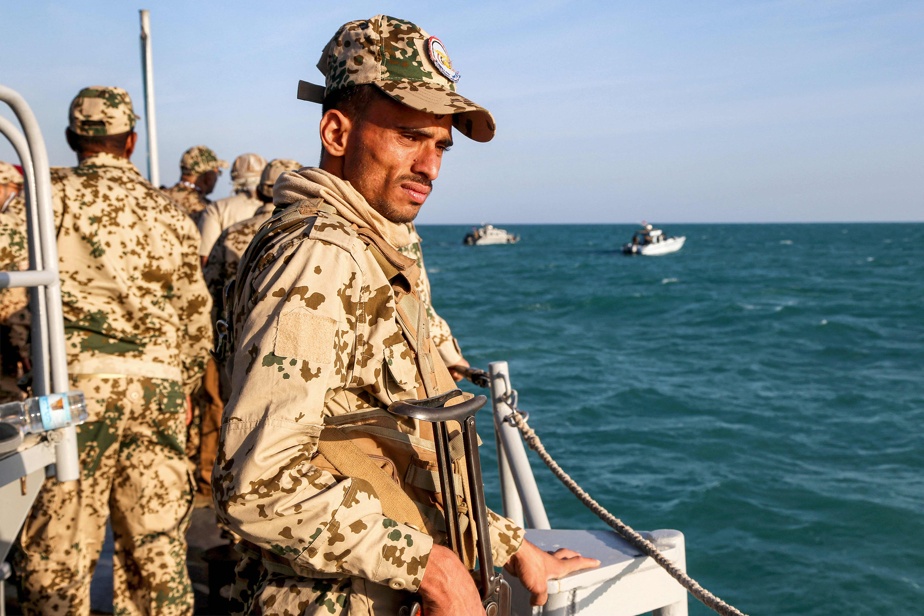(Paris) The increase in Houthi attacks in the Red Sea is dangerously raising tension in this crucial area for international maritime trade and fueling fears of uncontrolled slippage and regional conflagration.
Since the start of the war between Israel and Palestinian Hamas in Gaza, the Yemeni Houthi rebels, who have threatened to attack any ship heading towards Israel or having a link with this country, have increasingly stepped up operations. bold.
Drone attacks – one of the latest, this weekend targeted a French frigate –, assault on a merchant ship by helicopter last month, missile fire against a Norwegian oil tanker on Monday… In total, around ten attacks carried out in the name of the Palestinian cause by Houthi rebels, members of the “axis of resistance” against Israel, including Iran, Lebanese Hezbollah and Palestinian Hamas.
The Red Sea has been monitored like milk on fire by the international community for years: this “highway of the sea” linking the Mediterranean to the Indian Ocean, on which some 20,000 ships circulate each year, is a geopolitical zone and major commercial.
Some 40% of international trade passes through the Bab-el-Mandeb Strait separating the Arabian Peninsula from Africa, according to official figures.
“For the moment, we are still in a controlled skid, but it is a rather dangerous moment for the stability of this strategic region,” notes Camille Lons, researcher at ECFR (European council on foreign relations).
“The Houthis have the capacity to create considerable damage,” worries Fabian Hinz, of the IISS (International Institute for Strategic Studies).
If military ships cruising in the Red Sea can respond, as American and French vessels have recently done, this is not the case for commercial boats. “The US Navy cannot escort every civilian ship in the Red Sea,” he adds.
Iran’s role
All eyes are on Iran, considered the ultimate decision-maker in whether or not to open other fronts for Israel: in Lebanon with Hezbollah or in the Red Sea with the Houthis.
“Houthi equipment is mostly Iranian technology, but we know very little about Tehran’s involvement in decision-making,” explains Fabian Hinz.
The experts insist on the degree of autonomy of the Houthis, who “do not respond to Tehran, as does the Lebanese Hezbollah, the jewel of Iranian proxies (allied armed groups, editor’s note) in the region,” deciphers Camille Lons.
“The Houthis would exist with or without Iran,” underlines Franck Mermier for his part. “They have a religious and ideological proximity to him, but above all they are Yemeni fighters,” explains this Yemen specialist to the CNRS.
“I’m not sure the Iranians press the button on every attack,” he summarizes.
A radical political-military movement stemming from Zaidism, a branch of Shiism, the Houthis have their own agenda. Positioning themselves internally as champions of the Palestinian cause allows them to forget their inability to stabilize Yemen, but also to weigh in on the regional game at a time when fragile peace talks are underway with Saudi Arabia, which is seeking to exit. of the war in Yemen, where 400,000 people have died since 2014.
“So far the Houthis have struck without attracting massive reprisals, but things could get out of hand,” warns Mr. Mermier.
“If the world does not deal with this, because it is an international problem, we will act,” threatened the head of the Israeli National Security Council, Tzachi Hanegbi, on Saturday.
“The Houthis are completely unpredictable and dangerous. However, the processes that trigger war are always unpredictable,” recalls Franck Mermier.
“Iran has shown so far that it has no interest in letting the situation escalate regionally. However, Tehran has fewer levers over groups like the Houthis than over Hezbollah,” says M.me Lons.
Commercial implications
According to researcher Noam Raydan of the Washington Institute, available data suggests that several boats with Israeli connections (owner, destination, etc.) have been avoiding the Red Sea since the capture of the Galaxy Leader – whose crew is still detained – on November 19 and are bypassing Africa via the Cape of Good Hope, extending their journeys by two weeks.
Costs are increasing, as are insurance. “The risk of a major barrier to trade remains significant,” she wrote in a note on December 7.
